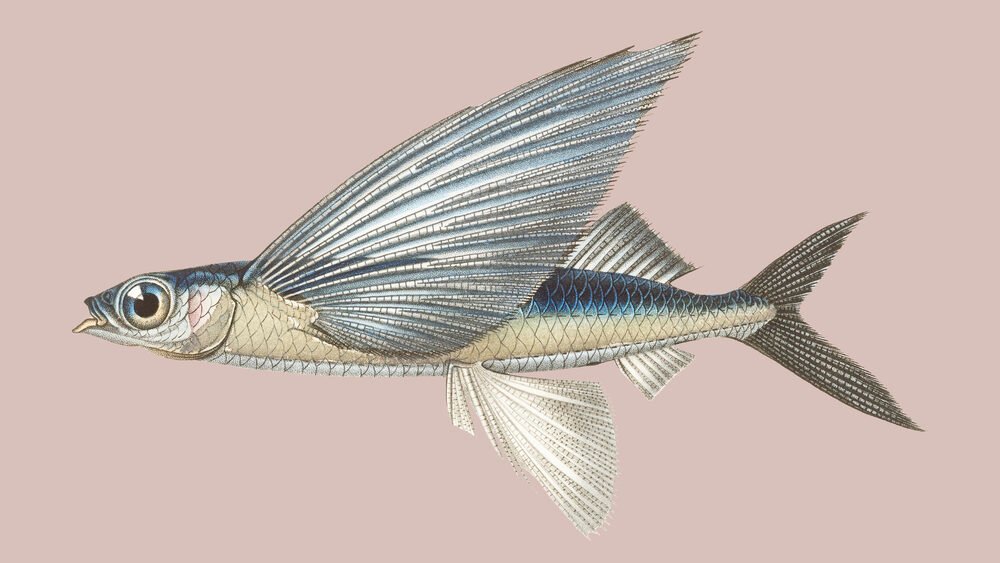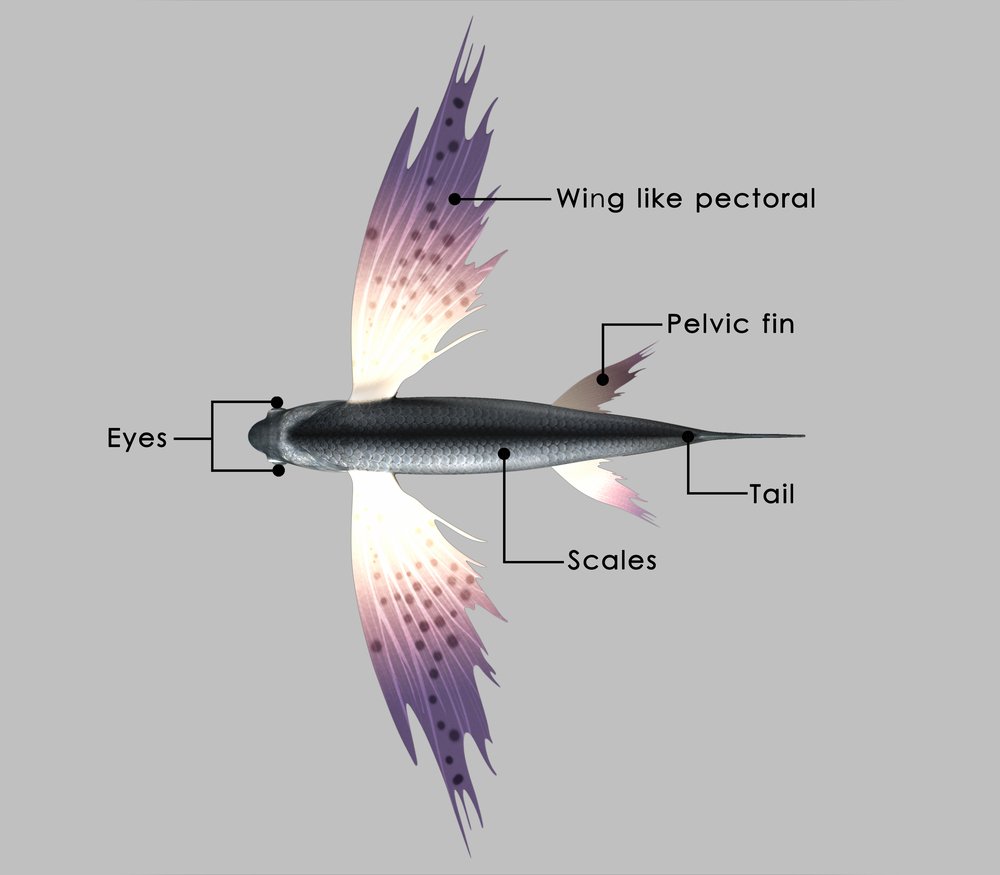Flying Fish Facts, Habitat, Classification & FAQ
Quick Interesting Facts about Flying Fish:
- Flying fish gets their name because they seem to have the ability to fly.
- They can not fully fly but rather leap out of the water and glide on their large wing-like fins.
- The reason they jump out of the water is to escape predators.
- Habitat: Warm ocean waters, mainly in the Pacific, Atlantic and Indian oceans.
- Flying fish can reach speeds of up to 40 mph when gliding and can cover distances of more than 400 feet.
- Their tail fin is used for propulsion when in the water and for lifting off when out of the water
- Their enlarged pectoral fins act as wings to help them stay aloft.
- They typically only fly for a few seconds to conserve energy.
- Their diet consists mainly of plankton, small shrimp, squid, and larvae.
Flying fish have evolved and adapted well to their environment, possessing large eyes that help them spot predators from afar and allow them to escape quickly with their unique flying skills.
What is a flying fish?

Flying fish is a species that has evolved to fly above the surface of the water.
Their typical length range from 17 to 30 centimeters, or 7 to 12 inches, and they can grow to be as long as 45 centimeters or 18 inches.
They are identifiable by their forked tail and enlarged pectoral fins on either side of their body. These enlarged fins enable them to take off from the water’s surface, while their pelvic fins help them soar through the air.
Biologists have discovered more than 40 species of flying fish, and occasionally new species are found and classified, each one adapting differently to meet its environment’s needs.
Some species have larger pectoral fins, which help them stay airborne for longer distances. Others have smaller pelvic fins and a forked tail that helps propel them forward as they fly.
Their predators are larger fish, such as tuna, mackerel, swordfish, and marlin.
No matter what type of flying fish you come across, they all share one common trait: the ability to escape predators by scooping above the ocean surface.
Habitat
The fish’s natural habitat is oceanic and coastal waters in the epipelagic zone. They live near the surface of the water, usually no deeper than 200 feet.
They live in open waters in tropical and subtropical regions of all the major oceans, including the Atlantic, Pacific, and Indian Oceans, and brackish waters, such as coral reefs, estuaries, and mangrove swamps.
Some people believe that a flying fish’s habitat is above the surface, but they only jump out of the water and stay above the surface temporarily to escape predators.
Frequently Asked Questions
Do flying fish exist, and do they fly?
Flying fish are real, but they do not fully fly despite their name. Instead, they propel themselves out of the water by flapping their tail to gain height and speed.
They glide through the air on their pectoral fins, acting as wings, above the surface through the air for short distances, and cannot sustain long flights.
Is flying fish edible, and how does it taste?

Flying fish are edible and are eaten in many places worldwide. It can be steamed, grilled, fried, or eaten as sushi, sashimi, or in salads and stir-fried dishes.
It is known to have white and firm flesh with a mild-flavored taste comparable to cod, high protein content, and low fat and carbs.
In Barbados, the national dish is flying fish and cou-cou with gravy.
The Japanese call the fish “tobiuo” and use it for dashi broth.
How did flying fish evolve, and why did they get wings?

Flying fish do not have wings but rather long and rigid fins, which it uses to glide through the air, reminding us of a bird’s wings. They are sometimes referred to as “two-winged” if they have large pectoral fins, or “four-winged” if they also have large pelvic fins.
One article in Quanta Magazine explains how researchers have developed a theory of the evolutionary need for the flying fish’s pectoral and pelvic fins, which are longer and more rigid than other fish, and the top and bottom fins are smaller and reduce air drag.
The theory suggests that changes in two genes caused these mutations and that bioelectrical signals in their tissue control the growth of their fins.
In other words, a slight gene change can cause significant growth in specific body parts.
Where is flying fish cove?
The capital of Australia’s Christmas Island is named Flying Fish Cove, but it has its name from the British ship HMS Flying Fish, not the fish.
Flying Fish Classification
Flying fish belong to the family Exocoetidae, which has four subfamilies, and these divide into seven genera based on their physical characteristics and behaviors.
Here is the taxonomical rank of the genus and species in the Exocoetidae family:
- Exocoetus genus:
- Gibbosus (Oceanic flyingfish)
- Monocirrhus (Barbel flyingfish)
- Obtusirostris (Oceanic two-wing flyingfish or blunt-snouted flyingfish)
- Peruvianus (Peruvian flyingfish)
- Volitans (Tropical two-wing flyingfish or blue flyingfish)
- Fodiator genus:
- Actus (Sharpchin flyingfish)
- Rostratus
- Parexocoetus genus:
- Brachypterus (Sailfin flying fish)
- Hillianus
- Mento (African sailfin flyingfish, yellow belly flying fish, Cuvier’s flying fish, or short-winged flying fish.
- Cheilopogon genus:
- Abei (Abe’s flyingfish)
- Agoo (Japanese flyingfish)
- Altipennis (smallhead flyingfish)
- Arcticeps (white-finned flyingfish)
- Atrisignis (glider flyingfish)
- Cyanopterus (margined flyingfish)
- Doederleinii
- Dorsomacula (backspot flyingfish)
- Exsiliens (bandwing flyingfish)
- Furcatus (spotfin flyingfish)
- Heterurus (Mediterranean flyingfish)
- Hubbsi (blotchwing flyingfish)
- Intermedius (intermediate flyingfish)
- Katoptron (Indonesian flyingfish)
- Melanurus (Atlantic flyingfish)
- Milleri (Guinean flyingfish)
- Nigricans (blacksail flyingfish)
- Olgae
- Papilio (butterfly flyingfish)
- Pinnatibarbatus
- Pinnatibarbatus californicus (California flyingfish)
- Pinnatibarbatus japonicus
- Pinnatibarbatus melanocercus (Australasian flying fish)
- Pinnatibarbatus pinnatibarbatus (Bennett’s flyingfish)
- Pitcairnensis
- Rapanouiensis (Easter Island flyingfish)
- Spilonotopterus (stained flyingfish)
- Spilopterus (manyspotted flyingfish)
- Suttoni (Sutton’s flyingfish)
- Unicolor (limpid-wing flyingfish)
- Ventralis
- Xenopterus (whitetip flyingfish)
- Cypselurus genus:
- Angusticeps (narrowhead flying fish)
- Callopterus (ornamented flying fish or beautyfin flying fish)
- Comatus (clearwing flying fish)
- Hexazona (darkbar flying fish)
- Hiraii
- Longibarbus
- Naresii (Pharao flying fish)
- Oligolepis (Large-scale flying fish)
- Opisthopus (black-finned flying fish)
- Poecilopterus (yellow-wing flying fish)
- Simus (short-nosed flying fish)
- Starksi
- Hirundichthys genus:
- affinis (fourwing flyingfish)
- albimaculatus (whitespot flyingfish)
- coromandelensis (Coromandel flyingfish)
- ilma
- indicus
- indicus indicus
- indicus orientalis
- marginatus (banded flyingfish)
- oxycephalus
- oxycephalus frereensis
- oxycephalus oxycephalus (bony flyingfish)
- rufipinnis (Redfin flyingfish)
- rondeletii (blackwing flyingfish)
- socotranus
- speculiger (mirrorwing flyingfish)
- volador
- Prognichthys genus:
- brevipinnis (shortfin flyingfish)
- gibbifrons (bluntnose flyingfish)
- glaphyrae (Gyre flyingfish)
- occidentalis
- sealei (sailor flyingfish)
- tringa (Tringa flyingfish)
The scientific classification of flying fish:
- Family: Exocoetidae
- Superfamily: Exocoetoidea
- Suborder: Exocoetoidei
- Order: Beloniformes
- Class: Actinopterygii
- Phylum: Chordata
- Kingdom: Animalia

